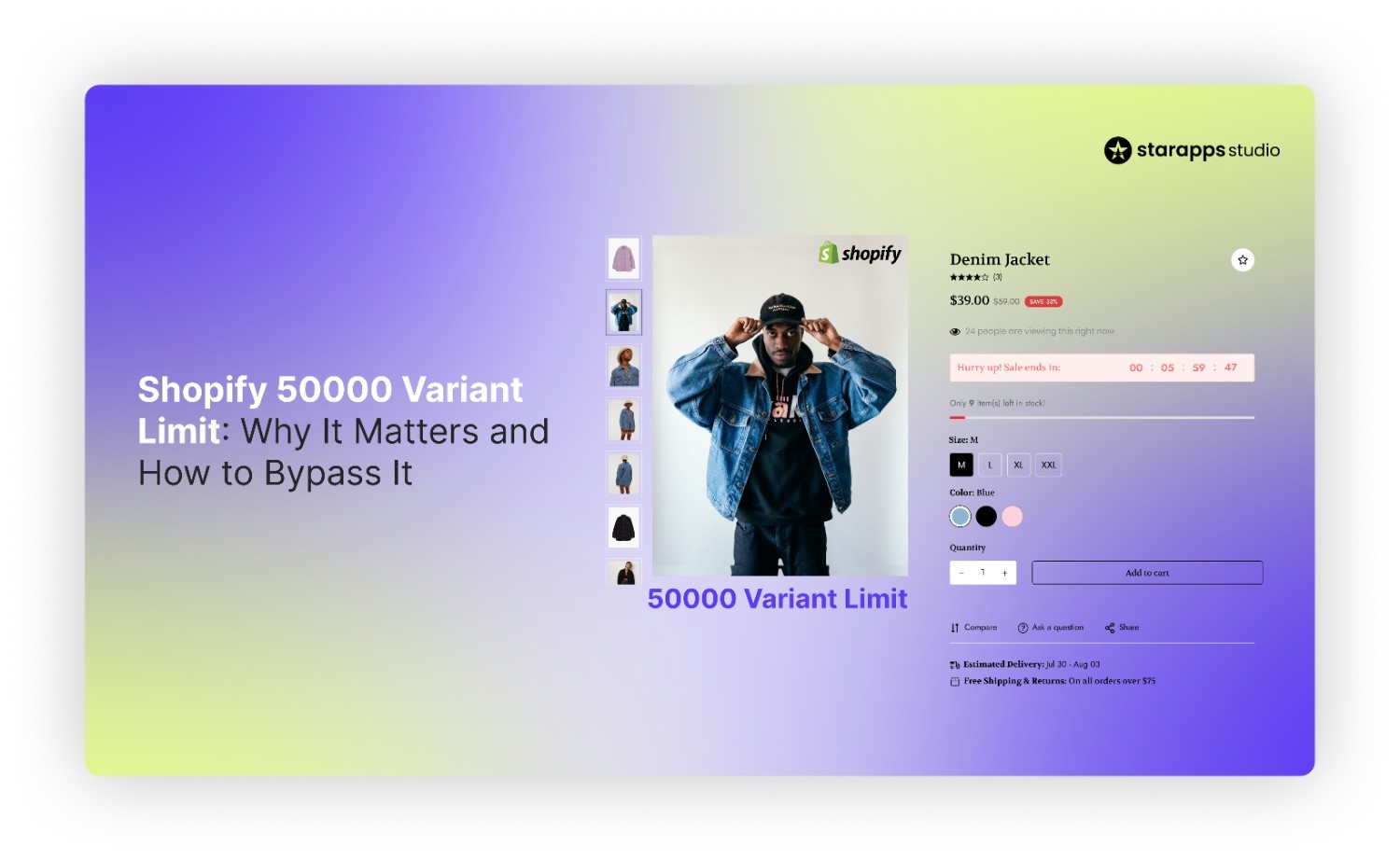
Master adding variants on Shopify! Create unique options, assign images, and use bulk edit tools effectively. Get started now!
Shopify’s product variant system allows you to offer different sizes, colors, materials, and styles within a single listing. But without the right setup, these variants can create more problems than they solve—misleading images, inventory mismatches, and limited control over how products appear to customers.
And visuals are critical: 75% of online shoppers say product photos influence their buying decisions. If a shopper selects “Red, Size Large” and sees the wrong image or no image at all, they’re more likely to abandon the purchase or buy the wrong item entirely.
This guide walks through how to set up product variants the right way. From understanding Shopify’s option and variant limits to managing structured data with metafields, assigning images, fixing theme-related issues, and applying best practices that scale, we’ll cover what you need to avoid costly mistakes and keep your store running smoothly.
What Are Shopify Product Variants?
In Shopify, a variant is a specific version of a product that combines one or more option values, such as size, color, or material. Each unique combination of these options becomes a distinct variant with its own price, SKU, inventory level, and image.
For example, if you're selling a t-shirt that comes in 3 colors (Red, Blue, Green) and 2 sizes (Small, Large), Shopify will generate 6 variants automatically, one for each possible color and size combination.
Each variant can have its own inventory, price, barcode, and image. This allows store owners to manage stock and display the right information to customers based on their selection.
Example: Variant Structure in Action
In this product listing, each color option (shown as swatches) and size selection creates a unique variant. For instance, selecting “Black” and size “8.5” corresponds to a specific SKU with its own inventory and image set. This is a classic example of how Shopify uses combinations of options, like color and size, to define and manage product variants.

Variants are a core part of product configuration in Shopify and are used across all industries—from fashion and furniture to food kits and tech accessories. They let you offer choices while keeping the product page unified under a single listing.
How many variants can be created on Shopify?
Shopify allows up to 3 product options (e.g., Color, Size, Material) and a maximum of 100 total variants per product. These limits apply across all plans and are enforced by Shopify’s core infrastructure.
Let’s say you create:
- 5 sizes
- 5 colors
- 4 materials
This setup would generate 5 × 5 × 4 = 100 variants, which is the platform limit. If you try to add a configuration that exceeds this, say, a 6th color, you’ll receive an error and won’t be able to save the new variant.
Can you add more than 100 variants on Shopify?
Not natively. Shopify’s standard system does not support more than 100 variants for a single product. However, there are workarounds if your catalog requires more flexibility:
- Split into multiple products: Break the product into separate listings based on a key attribute (e.g., create separate products for each material type).
- Use third-party apps: Custom Shopify App allows you to simulate additional options using custom fields or dynamic logic.
- Leverage Shopify Functions (Plus only): For high-volume stores on Shopify Plus, developers can sometimes simulate extended option logic using Shopify Functions or custom apps, but it’s complex and limited.
Shopify is gradually rolling out support for up to 2048 variants per product via its new GraphQL product model, which is currently available to Shopify Plus stores. The 3-option limit still applies, and standard Admin/REST users remain capped at 100 variants unless they migrate via GraphQL.
With the variant limits in mind, let’s walk through how to add and edit product variants directly in Shopify.
How to Add or Edit Product Variants in Shopify
Managing variants starts with assigning option values like size, color, or material, and letting Shopify generate all valid combinations. From there, you can customize each variant’s pricing, inventory, and image.
How to Add Product Variants
You can add variants when first creating a product or later by editing it.
Steps:
- Go to your Shopify Admin, then click Products.
- Select an existing product or create a new one.
- Scroll to the Variants section and click Add options like size or color.
- Enter the option name (e.g., Size) and values (e.g., S, M, L).
- Add up to 3 option types per product.
- Shopify will automatically generate a list of all possible variant combinations.
- Review the list, uncheck combinations you don’t sell, and click Done.
Each variant will now appear in a list where you can manage stock, prices, SKUs, barcodes, and individual images.
How to Edit Existing Variants
Need to change a price, adjust inventory, or replace an image? You can do that for any variant without deleting it.
Steps:
- Go to Products and open the product you want to edit.
- Scroll to the Variants table.
- Click the row for the variant you want to update.
- In the variant drawer, edit:
- Price
- Compare-at price
- Inventory
- SKU
- Barcode
- Image
- Save your changes.
If you want to rename or remove an option (like switching “Tan” to “Beige”), do so from the Options section at the top of the product editor, not inside each variant.
After setting up and editing your variants, the next step is linking the right image to each one, especially when visual differences matter to the buyer.
How to Add Images to Product Variants
Once your product variants are created, assigning the correct image to each one helps customers visually confirm their selection, especially when variants differ by color, pattern, or design. Shopify allows you to link one image per variant using the Admin dashboard. This ensures that when a customer selects, for example, “Red / Large,” the red product image displays automatically (if supported by your theme).
Steps to add an image to a variant:
- In your Shopify Admin, go to Products and select the product you want to edit.
- Scroll down to the Variants section.
- Click on the specific variant (e.g., Size: Medium, Color: Blue).
- A side panel will open, click Add image or Select image.
- Upload a new image or choose one from your media library.
- Click Done, then Save the product.
Repeat this for each variant that requires a unique image. Once assigned, Shopify will display the image when that variant is selected, assuming the theme supports dynamic image switching.
For stores managing a large catalog or aiming for consistency across product options, Shopify also offers a more structured approach using category metafields.
Adding Variants Using Category Metafields (for Structured Data Control)
If you're managing a large catalog or want to maintain consistency across product options, Shopify now allows you to add variants by linking them to category metafields. This approach makes option values reusable and easier to update across your store.
For example, if you use “Black” as a color option on dozens of products, but later want to rename it to “Graphite,” you only need to update the name once from the Content > Metaobjects page, Sand hopify will update it everywhere it’s referenced.
This is especially useful when:
- You sell products across multiple collections that share the same options
- You want centralized control over option labels and translations
- You use apps or automation tools that depend on structured product data
Steps to Add Variant Options via Category Metafields:
- In your Shopify Admin, go to Products.
- Click the product you want to edit.
- In the Variants section, click + Add options like size or color.
- If a category metafield is available, select it. Shopify will auto-fill the option values from your existing entries.
- You can select from existing values or click Edit → Add new entry to create a custom value (e.g., a new color).
- Click Save to finalize your product changes.
This method reduces manual effort and gives you more control over how product data is created, reused, and edited, especially helpful if you're managing 50+ SKUs or scaling across markets.
If you're working with similar variants and don't need structured metafield control, there's a faster option: duplicate an existing variant and adjust only what’s different.
Adding a Variant by Duplicating an Existing One
If you’re adding a variant that’s similar to an existing one, just with a slight change in size, color, or other detail, duplicating can save time.
This method is useful when many attributes (like price, SKU, barcode, or shipping settings) remain the same, and you only need to modify one option value. The duplicated variant inherits the details of the original but must have at least one unique option value to be saved.
Important Notes:
- You can’t save an exact duplicate of an existing variant.
- This method only creates one new variant at a time—it doesn’t generate combinations across all options.
- Bulk duplication requires selecting multiple variants and using Shopify’s bulk editor.
Steps to Duplicate a Variant in Shopify:
- In your Shopify Admin, go to Products.
- Click the product you want to edit.
- In the Variants section, click the variant you want to duplicate.
- Click Duplicate.
- Change at least one option value (e.g., change “Size: Medium” to “Size: Large”).
- (Optional)Update the image, price, quantity, SKU, barcode, or other fields as needed.
- Click Save.
This is especially handy when you’re expanding an existing product, like adding a new size or material, but want to keep everything else consistent.
Once your variants are set up, it’s common to run into issues that aren’t obvious during setup, but can affect how they behave or display. Below are some of the most frequent problems store owners face, and how to resolve them.
Common Product Variant Issues in Shopify (And How to Fix Them)
Variants can behave unpredictably on the storefront if certain settings are missed or if your theme and apps don't support advanced logic. Below are some of the most common issues merchants face, and how to fix them without affecting live listings.
- Variant Not Displaying on the Storefront
A variant you've added doesn't appear to customers, even though it's listed in the admin.
Causes:
- The variant was accidentally unchecked during setup.
- It’s out of stock, and inventory tracking is enabled with no backorders.
- Visibility is limited by an app or custom theme setting.
Fix:
- Go to the product and check if the variant is active and has inventory available.
- Ensure all variant combinations are enabled in the options list.
- Preview the product in an incognito window to rule out theme or cache issues.
- Check for custom code or third-party apps hiding unavailable variants by default.
- Price or Inventory Changes Not Saving Across Variants
You update the price or inventory for a variant, but it either doesn’t reflect in the storefront or overwrites other variants unexpectedly.
Causes:
- Edits made in bulk may have applied to all variants accidentally.
- App-based overrides may delay or override live admin values.
- Variant duplication without unique SKUs or identifiers.
Fix:
- Double-check each variant’s row for the correct value—do not assume bulk edit saved properly.
- Wait for sync to complete if you're using an inventory or pricing app.
- Assign unique SKUs for all variants to prevent backend conflicts.
- Variant Image Doesn’t Switch on Selection
When a customer selects a variant (like “Green”), the product image doesn’t change, even though an image is assigned in the admin.
Causes:
- The current theme doesn’t support dynamic image switching.
- Image wasn't properly linked to that variant.
- Conflicts with swatch/image-display apps.
Fix:
- Confirm the image is assigned to the exact variant via Shopify Admin.
- Test your store with a Shopify 2.0 theme like Dawn or Refresh.
- If using an app (e.g., for swatches or zoom), disable it temporarily to test native behavior.
- Use an app like SA Variant Image Automator for consistent, theme-independent behavior.
- Variant Selector Glitches on Mobile
Swatch buttons or dropdowns don’t respond or overlap on mobile devices.
Causes:
- Theme responsiveness issues.
- App scripts are not optimized for mobile breakpoints.
Fix:
- Test the storefront on mobile and tablet breakpoints.
- Check if the issue persists after switching to a default theme.
- Contact theme support or use a mobile-optimized Shopify 2.0 theme.
Fixing problems after they appear is one part of variant management, but setting things up right from the start prevents most of them. That’s where consistent practices make a difference.
Best Practices for Managing Product Variants
The following practices can help prevent setup errors, simplify updates, and create a smoother experience for both you and your customers.
- Use clear, consistent naming conventions: Keep variant option values uniform (e.g., "Large" not "Lrg") to avoid confusion across apps, exports, or reports.
- Assign SKUs to every variant: Even if you don’t use barcodes, unique SKUs help track inventory, sync across platforms, and avoid backend errors.
- Compress and standardize variant images: Use consistent image dimensions, aspect ratios, and file formats. This keeps your gallery clean and loads faster.
- Audit variant behavior after setup: Always test on desktop and mobile to confirm selection logic, image switching, and availability behave as expected.
- Limit variants when possible: Avoid creating excessive combinations that could trigger the 100-variant cap. Prioritize customer-relevant options.
- Use metafields or apps for advanced logic: For tiered options (e.g., size + color + material), structured data via metafields or third-party apps reduces complexity.
- Keep option values reusable: If you frequently use the same values (like colors or finishes), store them via category metafields for easier future edits.
Final Thoughts
Mistakes in how product variants are set up often surface later, through incorrect pricing, broken images, or limited discoverability. The more complex your catalog, the more important it becomes to organize your variants in a way that’s accurate, scalable, and easy for customers to understand.
If your goal is to highlight every version of a product, without duplicating listings or cluttering your admin, there’s a tool designed for that.
Split Variants Visually with SA Variants: Combined Listings
Instead of duplicating products manually, use SA Variants: Combined Listings to display each variant as an individual item on your collection pages, complete with its own image, title, and URL. On the product page, variants still stay grouped for a clean buying experience.
This gives you:
- Better visibility in search and collections
- Unique links for each variant (great for SEO and marketing)
- A more intuitive browsing experience for customers
No complex setups. No theme rewrites. Just a smart variant presentation built for scale. Try SA Variants: Combined Listings on Shopify
FAQ
Q1: Can I have more than three options for a product (e.g., Size, Color, Material, Fit)?
No. Shopify only allows three option types per product, regardless of how many values each one has. You’ll need to combine or flatten options (e.g., “Slim Fit / Red”) or use apps for more flexibility.
Q2: What happens if I hit the 100-variant limit?
Shopify blocks new variant creation beyond 100 combinations. You can either split the product, reduce combinations, or—if you're on Shopify Plus—work with a developer to migrate to the GraphQL model, which supports up to 2048 variants.
Q3: My variant image is assigned, but it is not switching. Why?
Most likely, your theme doesn’t support dynamic image switching. Test it on a Shopify 2.0 theme or use an app like SA Variant Image Automator to control image behavior independently of theme limitations.
Q4: Can I bulk assign images or data to variants?
Not directly in the Shopify admin. However, you can use CSV import/export or third-party apps that allow bulk editing of variant images, pricing, and other fields.
Q5: How can I show each variant separately on my collection page?
Use SA Variants: Combined Listings. It lets you feature each variant (with its own image and URL) in your storefront while managing them as a single product in your admin.
Heading
End-to-end traceability
To ensure regulatory compliance, you must have a complete overview of your products from production to shipping. Book a demo to see how Katana can give you full visibility of your operations.





.png)
.png)